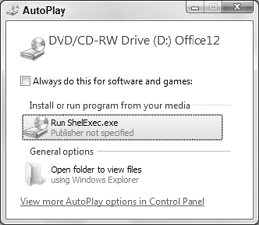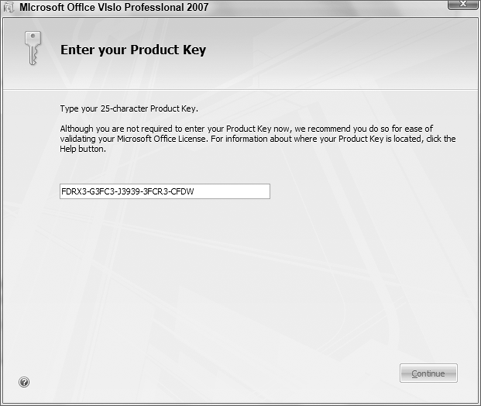Even though every program is unique in some
ways, you're likely to come across some common elements during a
program installation. When you install a program, you probably won't
see all the prompts described in the sections to follow, so don't be
alarmed if your installation procedure is much simpler. (Be thankful
instead.)
1. The initial CD or DVD prompt
Shortly after you insert the installation disk for a program, you may see a prompt like the one in Figure 1. Your choice there is easy — click the Run SETUP.EXE option (which might show an executable other than SETUP.EXE, as in Figure 1).
2. Enter an administrator password
Only people with administrative privileges can
install programs in Windows 7. If you're signed into a limited account,
you'll see a dialog box asking you to enter an administrative password.
If you are already logged on with an administrative account, Windows 7
asks you if you want to allow the program to make changes to the
computer. Click Yes to continue with Setup.

3. The product key or serial number
Some programs (especially Microsoft's) require that
you enter a product key or serial number to install the program. That
number is usually on a sticker on the case or sleeve in which the
program was delivered.
|
You may want to keep track of all your product keys
in a WordPad document or other type of document in case you ever need
to reinstall everything. Print a copy of the document and keep it safe
in case your hard disk crashes. Belarc (www.belarc.com)
offers a free program called Belarc Adviser that will list the product
keys for all your installed programs, as well as a good deal more
useful information about your systems. One of those free programs
that's worth its proverbial weight in gold! Also check out Magical
Jelly Bean Finder, at magicaljellybean.com/keyfinder.
|
|
If you do need to enter a product key or serial number, you'll see a prompt similar to the example shown in Figure 2.
Type in the product key exactly as provided by the software developer,
and click Continue (or whatever button the installation program offers
to continue the installation process).
4. Compliance check
If you are installing the Upgrade Edition of a new
program, and already have the older version installed on your computer,
likely the installation program will detect the existing product and
move through the upgrade. In other situations, particularly where you
don't already have a previous edition of the program installed, you
might be prompted to insert the CD for the old version and/or enter the
product key for the old version. This depends entirely on the
requirements of the application's upgrade program. Follow the prompts
displayed by the upgrade program to provide the requested information.
NOTE
You might see a message asking what you want to do with the CD you just inserted. You do not
want to install the program on the CD. The goal here is to simply prove
you have the older version, not to install the older version. So if you
do see a dialog box asking what you want to do with the CD, click the
Close (X) button in the upper-right corner of that dialog box.

5. User information prompt
Some programs will offer prompts like the ones in Figure 3.
These are optional, but useful. The username will automatically be
entered as the Author name in any documents you create with the
program. The initials will be used in settings where multiple people
edit documents to identify changes you made to the document.
6. The End User License Agreement (EULA)
Just about every commercial program and most
freeware and open source programs require that you accept the End User
License Agreement (EULA) as part of the installation process. Figure 4
shows an example. The agreement is a legal document that defines your
rights to the program, as well as the developer's retained rights.
The EULA differs from one program to the next. In
most cases, the EULA gives you the right to install a program on one
computer. However, that is not always the case. The EULA for Microsoft
Office 2007 applications, for example, allows you to install the
software on a licensed device (such as your desktop computer) and one
portable device (such as your notebook PC). The intent of this clause
is that you will only use the software on one computer at a time.
What's more, you can access and use the software on the device remotely
from any other device. For example, this means you can connect to your
office PC from home and run the Office application remotely on your
office PC (or vice versa).
Although many people never read the EULA when
installing a program, you should take the time to do so. You'll
discover interesting bits of information (such as being able to install
Office on more than one computer), but also potentially discover
possible problems. For example, I've seen EULAs for shareware and
commercial programs that explain that the Setup program will install
other, third-party applications along with the program, and that by
accepting the EULA you are indicating your acceptance of those other
programs. These programs might have nothing to do with the program you
are installing, such as weather monitors, Internet Explorer add-ons and
toolbars, and so on. Often the installation program will give you the
option of not installing these additional programs, but that's not
always the case. So, my best advice is to always read the EULA.

You can't install the program if you don't
accept the terms of the agreement, so assuming you are happy (or at
least resigned) to the terms of the EULA, select (check) the I Accept
option and click Next, Continue, or whatever button continues the
installation process.